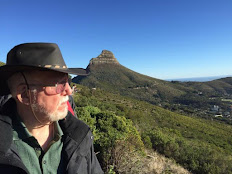MARQUETTE -- Concerns about protecting religious freedom intersected with the desire to safeguard public land access when approximately 100 concerned citizens held a Forum Tuesday evening, Apr. 27, in Marquette, in response to Rio Tinto-Kennecott's (RT-K) start of construction on a nickel and copper mine 25 miles west of Marquette.
"Everything that we do is non-violent, peaceful. We just want to bring awareness and education to the public and ourselves in this process," said Big Bay resident Cynthia Pryor, who was recently arrested for trespassing on public land leased by Kennecott.
 Cynthia Pryor of the Yellow Dog Watershed Preserve addresses a crowd of about 100 concerned citizens at the Apr. 27 Forum on sulfide mining held at the Women's Federated Club House in Marquette. (Photos by Keweenaw Now unless otherwise indicated.)
Cynthia Pryor of the Yellow Dog Watershed Preserve addresses a crowd of about 100 concerned citizens at the Apr. 27 Forum on sulfide mining held at the Women's Federated Club House in Marquette. (Photos by Keweenaw Now unless otherwise indicated.)Pryor, who is also the Yellow Dog Watershed Preserve Sulfide Mining Campaign director, opened the forum with an account of her arrest on April 20, her time in jail and her release on personal recognizance on April 22.
The Yellow Dog Watershed Preserve is an organization whose mission is to preserve and protect the Yellow Dog River and surrounding watersheds for the benefit of present and future generations through grassroots organizing.
"We monitor the Yellow Dog Plains," Pryor explained, "just to keep track of actions of Kennecott to ensure that everything is going according to the law."
Pryor describes arrest on public land
Pryor described how, when she went with her dog for a drive and walk on the Yellow Dog Plains on April 20, she was surprised to see a bulldozer on the public land. It was not running, but the operator was there.
"I had assumed that all of their work was being done on their property, which they owned right to the east of the (Eagle) Rock," Pryor said, "so I was quite surprised to see this bulldozer sitting there (on the public land)."
After a series of conversations with the "cordial" operator, a security guard and law enforcement officers, she was arrested, after refusing to leave, for trespassing on part of the 120-acre area of land the state has leased to RT-K.
Pryor and mine opponents claim the lease is invalid and that the company has also sidestepped a permitting process with the federal Environmental Protection Agency. In addition, "No Trespassing" signs were reportedly not posted in the area until after her arrest.
When an RT-K security guard and law enforcement officials accused her of trespassing, Pryor said, she told them she was not, that she was a citizen of Michigan on public land and had the right to be there.
As a result of her stand, Marquette County Sheriff and Michigan State Police officers arrested Pryor and she was taken to jail on April 20. Since she refused bail, Pryor was released on personal recognizance on April 22 and will face a pretrial conference on a misdemeanor trespass charge on May 6. Pryor added that talking with inmates during her night in jail gave her a sense of support and that she received a cheer of "Power to the people" from them upon release.*
While she described some aspects of her time in jail with humor, Pryor added, "It's not a fun thing. It's a serious matter to be in jail."
Pryor has retained a lawyer and said she plans to fight the charges before a jury. RT-K began site preparation work on April 19 after the Michigan Department of Environmental Quality issued permits in early March before it combined with the Department of Natural Resources.
The multinational mining company plans to tunnel under the Salmon Trout River to exploit a rich ore body; opponents claim the Eagle Project mine would produce acid mine drainage when reactive sulfide-containing ore is exposed to air and water.
Opponents fear significant impacts on water and air quality, fish and wildlife habitat and human health. They also believe the mine has a significant chance of collapsing and causing major damage to a pristine trout stream within the Lake Superior watershed.
Protesters camp at Eagle Rock
Members of the Keweenaw Bay Indian Community (KBIC) and others opposed to the mine established an encampment at Eagle Rock (Migi zii wa sin) on April 24 in solidarity with Pryor and as a witness to the Rock's religious significance. RT-K proposes to work in the vicinity of this outcropping that Ojibwe people recognize as a sacred pilgrimage site for spiritual ceremonies. The campers have been tending a sacred fire at the rock and plan to stay indefinitely.
 Protesters camping on Eagle Rock on Sunday, Apr. 25. The woodpile is for the sacred fire they are tending.
Protesters camping on Eagle Rock on Sunday, Apr. 25. The woodpile is for the sacred fire they are tending.The Rev. Jon Magnuson, a Lutheran campus pastor at Northern Michigan University, spoke at the April 27 forum in support of Pryor's action of civil disobedience.
Magnuson said Pryor's decision has profound spiritual, ethical and moral dimensions -- that it has brought her into the tradition of civil disobedience that helped to found American society. Making reference to such leaders as Gandhi and Martin Luther King, Jr., Magnuson noted this tradition propelled the country to end injustices like slavery, denial of the right to vote for women and African Americans, and unjust wars such as the Vietnam conflict.
"One of the fascinating parts of [Cynthia's] story is this was not a staged, strategic decision," Magnuson noted. "This was a heart-gut decision that she made when she was asked to leave and responded, 'No, I'm not trespassing; you are trespassing. You don't have the right permits here. I'm on state land.'"
Magnuson noted this peaceful civil disobedience is guaranteed under the First Amendment of the U.S. Constitution that guarantees freedom of speech and freedom of religion.
Magnuson said he is one of about 100 religious leaders from the UP who signed a statement in 2005 supporting KBIC's opposition to the mine. He mentioned treaties guaranteeing the Ojibwe hunting, fishing and gathering rights -- including religious purposes -- that Kennecott threatens to circumvent in order for the mine project to move forward despite its inevitable impacts on the environment.
 At the Apr. 27 Forum, the Rev. Jon Magnuson, a Lutheran campus pastor at Northern Michigan University, displays a list of 100 religious leaders from the UP who signed a statement in 2005 supporting KBIC's opposition to the mine.
At the Apr. 27 Forum, the Rev. Jon Magnuson, a Lutheran campus pastor at Northern Michigan University, displays a list of 100 religious leaders from the UP who signed a statement in 2005 supporting KBIC's opposition to the mine.Eagle Rock is similar to St. Peter's Cathedral in Marquette, Magnuson noted, because of the Rock's spiritual significance to the Ojibwe. Magnuson said if something of great value were found under a cathedral like St. Peter's and an international company wanted to blow up the cathedral, there would be an uproar of protest.
"This community would not allow that to happen," he said.
Magnuson termed the Ojibwe's access to and protection of Eagle Rock "a basic human right to freedom of expression of religious practices." Earlier this year State of Michigan officials took the stance that a religious site must be a building to qualify for protection.
Rio Tinto's anti-union policy
Magnuson added that he and mine opponents support regional job creation, but do not consider short-term mining projects with potential major social and environmental impacts to offer a stable long-term economic future.
On the subject of jobs promised by Kennecott, Gail Griffith read her recent letter to the Marquette Mining Journal Editor, calling attention to RT-K's "aggressive anti-union policy." She cited their recent lock-out of Borax workers in California.**
 Gail Griffith speaks about Rio Tinto's anti-union policy during the Apr. 27 Forum on sulfide mining.
Gail Griffith speaks about Rio Tinto's anti-union policy during the Apr. 27 Forum on sulfide mining.Eagle Rock's spiritual significance
KBIC Historic Preservation Officer Summer Cohen confirmed Eagle Rock's spiritual significance and said she has been documenting this through interviewing tribal members. Cohen said mining would place Eagle Rock in danger and company assurances they would not harm the rock's surface miss the point.
"It actually goes deeper than just the surface [of Eagle Rock]," Cohen said. "It's like a person, a living thing -- it [mining in the vicinity] would destroy that spirit there."
Pryor shared her experience with the Rock saying its domination of the surrounding landscape provides a "refuge feeling." Pryor said state and corporate disrespect for tribal spiritual traditions and practices reinforce her concerns about how efforts to establish the mine are eroding the public's access to state lands.
Pryor also read a statement from KBIC member Jessica Koski, who attended the Rio Tinto Annual General Meeting in London, England, on April 15, 2010, to speak to the company's shareholders about how the sulfide mine threatens the environment and violates Native American rights.
Koski writes in her statement, "In response to my concerns raised at the AGM, Chairman Jan du Plessis and CEO Tom Albanese wanted to assure me that the United States and the State of Michigan have some of the toughest environmental laws in the world, and that the company would comply with them. They also claimed that a modification to the mine permit moved the mine portal away from Eagle Rock.
"I am disappointed that a country and state with supposedly the toughest environmental laws is allowing Rio Tinto to stomp on our rights and self-determination. A modification of the mine portal will still blast into and beneath Eagle Rock and destroy the integrity of this site," Koski writes.***
Three of the campers who initiated the Eagle Rock witness attended Tuesday's meeting. Charlotte Loonsfoot and Chalsea Smith, KBIC members, and Georgenia Earring of the Cheyenne River Sioux tribe, who now lives in Baraga and is married to KBIC member Chris Chosa, shared their motivations and perspectives with the audience.
 Three Native American women who have been camping on Eagle Rock in opposition to the sulfide mine and in support of Cynthia Pryor, speak at the Apr. 27 Forum. From left, they are Chalsea Smith, Charlotte Loonsfoot and Georgenia Earring.
Three Native American women who have been camping on Eagle Rock in opposition to the sulfide mine and in support of Cynthia Pryor, speak at the Apr. 27 Forum. From left, they are Chalsea Smith, Charlotte Loonsfoot and Georgenia Earring."I'm worried about our water," Loonsfoot said.
"We're here to help out," Smith said. "We built the sacred fire right on the spot where they're going to blow it up."
Smith said that currently there is a 500-foot buffer zone between the encampment and RT-K construction activity. She added that donations of firewood, food and other supplies would be helpful. Smith and Loonsfoot encouraged the presence of visitors and additional campers as long as they do not bring drugs, weapons, or alcohol.
Earring said they decided to go to Eagle Rock as soon as they heard about Pryor's arrest.
"I was inspired by Cynthia," she said. "We were at the Family Dollar in L'Anse [on Wednesday, April 21] and we decided to grab some supplies and we went out there."
Gabriel Caplett, a citizen journalist active in publicizing the sulfide mining issue, reiterated the dual nature of the conflict with RT-K and the state of Michigan. Caplett said the future of public land rights in the UP and the treatment of sacred sites will be on-going themes in citizen efforts to prevent mining on the Yellow Dog Plains and elsewhere.
 Gabriel Caplett, who has recently published his articles on the sulfide mining issue on the Web site Headwaters News, speaks about the protest on Eagle Rock.
Gabriel Caplett, who has recently published his articles on the sulfide mining issue on the Web site Headwaters News, speaks about the protest on Eagle Rock."I think the main point right now is that we need people out there to camp there," Caplett said. "If you can't camp out there, then stop by, bring them something, say hello to them."
Campers need supplies, safety
Caplett emphasized the need for a peaceful approach and safety. He expressed concern about hostile and violent comments directed at mine opponents over the Internet after Pryor's arrest. Caplett said there even have been calls for bulldozer operators to drive over people resisting the mine, although those were suddenly pulled from the Internet this week. Caplett encouraged people to have video cameras, cell phones and other recording devices available hopefully to deter but, if necessary, to capture any violence.
Caplett said he believed Kennecott was on the defensive since their authority to put no trespassing signs or to arrest people is questionable.
"Kennecott still needs the legal authority from the federal government to even bulldoze out there," Caplett noted. "They've bulldozed on our public property out there."
Caplett said people visiting Eagle Rock are not sure of Kennecott's "arbitrary boundary" on land that is actually public.****
Amy Conover, a concerned Marquette citizen and board member of UPEC (Upper Peninsula Environmental Coalition) said during the meeting that she felt safe on Eagle Rock. She's been supporting the protesters camping there by bringing supplies and making sure they're safe.
"My understanding is that they will maintain a presence there for as long as it is viable, and my intention is to maintain support so they can maintain viability for as long as it is necessary," Conover said.
Pryor asked people in the audience to let her know if they plan to go out to Eagle Rock and how long they intend to be there and to report to her after their visit. Her email is cpryor@isp.com.
Teresa Bertossi of Headwaters News had spent several days on Eagle Rock and expressed concern about safety issues.
"We need more people out there for safety reasons," Bertossi said.
Lillian Heldreth, retired Northern Michigan University professor of English and Native American Studies, said she was familiar with the safety issue because of her experience with coal mining companies in West Virginia.
"I come originally from West Virginia, where we know not to trust any mining company. Massey Coal just killed 29 people," Heldreth said. "All Michigan is providing in their so-called strict laws will be the same kind of slap on the wrist that West Virginia has given the coal companies. The reason that accident happened is they could ignore about 300 safety citations."
Citizens' lawsuit feasible
Michelle Halley, an attorney and Lake Superior Project manager with the National Wildlife Federation (NWF), discussed options for a citizens' lawsuit (citizen-funded, citizen-driven) under the Michigan Environmental Protection Act (MEPA), since MEPA has a broad standard for environmental protection and a fairly liberal standing requirement.
 Michelle Halley, National Wildlife Federation attorney and Lake Superior Project manager, who has been working on a contested case against the proposed sulfide mine, spoke at the Forum about the possibility of a citizens' lawsuit against the company.
Michelle Halley, National Wildlife Federation attorney and Lake Superior Project manager, who has been working on a contested case against the proposed sulfide mine, spoke at the Forum about the possibility of a citizens' lawsuit against the company."Standing means that the parties who are bringing the suit are the best and proper parties to bring the suit," Halley said.
Citizens with standing could join in a suit and would have to show impacts they would experience from the mine. Adjacent landowners might address air pollution, residents downstream could focus on water quality issues, tribal members could address loss of religious rights, and people who have recreated in the mine's vicinity could cite the loss of access. All parties to the suit would have to establish standing, and the group would have to raise funds to engage legal counsel. Halley said she would be willing to meet with interested citizens to discuss details and possible attorneys.
"Some people say, 'Well, couldn't we just do it ourselves?'" Halley added. "You can. You have the right to represent yourself in court. It's a hard way to go, and MEPA is not a simple statute."
Halley said she could direct people to resources to help them with the statute. In addition, because the NWF and other groups have already engaged in much discovery of facts and elicited statements from expert witnesses, Halley said this could be shared with a citizens' lawsuit and save some expense.
Kristi Mills of Save the Wild UP said SWUP is working with other groups and trying to keep their Web site up-to-date on the sulfide mining issue. She mentioned other Web sites to consult as well, including Headwatersnews.net and Stand for the Land.
 Kristi Mills of Save the Wild UP announces coming events related to the sulfide mining issue and Web sites to consult.
Kristi Mills of Save the Wild UP announces coming events related to the sulfide mining issue and Web sites to consult."We need a lot of people on the street, and we need a lot of people out at the Rock," Mills said.
At the end of the Forum, Pryor handed out letters to Governor Jennifer Granholm and environmental justice petitions to gather signatures. These are now available on the Yellow Dog Watershed Preserve blog.
A petition to support Cynthia Pryor (not the same as the petition mentioned above) is available on savethewildup.org. Donations can also be made on line to a legal defense fund through savethewildup.org.
* Click here to see a You Tube video interview with Cynthia Pryor describing her arrest.
** See the video clip of Dave Irish, representing workers at Rio Tinto's Borax Mine in California, speaking at Rio Tinto's Annual General Meeting concerning the company's lock-out of more than 500 workers with the aid of a union-busting firm.
*** See the video clip of Jessica Koski speaking at Rio Tinto's Annual General Meeting Apr. 15.
**** According to an April 28 article in the Mining Journal, Kennecott spokeswoman Deb Muchmore said Kennecott planned to put "safety and environmental fencing" around Eagle Rock.
Editor's Notes: For correspondence and other documents related to Kennecott's application for a federal Underground Injection Control permit, see the EPA Web site with links.
Update: For a sample letter to use as a model for writing to the EPA, click here or go to the Get Involved page on Stand for the Land.
For letters from KBIC to the EPA and other documents concerning Eagle Rock as a sacred site in need of protection from the proposed sulfide mining, click here.
Click here for information about the next rally -- to precede Cynthia Pryor's hearing on May 6.

































































































































No comments:
Post a Comment